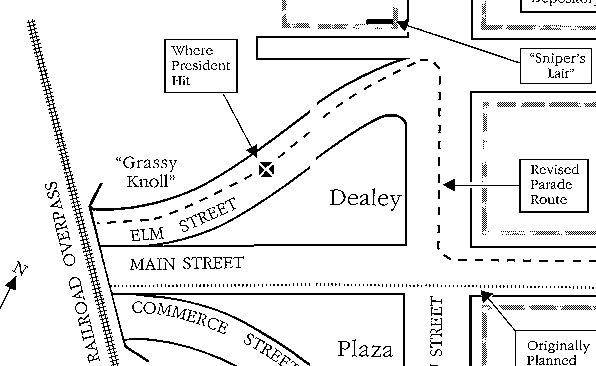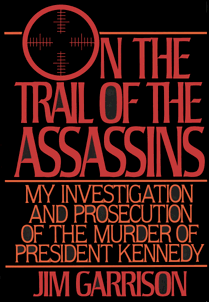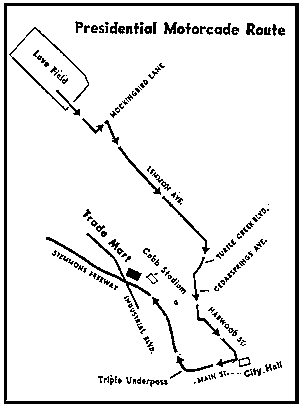

Why is this supposed to be sinister? Because the route down Elm Street takes the limo near the Grassy Knoll, where a shooter was supposedly stationed. It also takes the motorcade near other buildings (such as the Dal-Tex) were shooters could be hidden, supposedly creating a "triangulation of crossfire."
Below is a drawing of the "originally planned" parade route, and the "revised" parade route -- taken from On the Trail of the Assassins is shown below.

The temporary respite from the investigation did not last long. Frank Klein could not stay away from it, and neither could I. One morning I was in my office reading and rereading a newspaper. I did not hear Frank enter.So the very sage, very perceptive Garrison caught the Warren Commission in a "coverup" of a key piece of evidence. According to Garrison."I have never seen you so preoccupied," said Frank.
"It's not just any paper, son," I said. "This is the front page of the Dallas Morning News for November 22, 1963."
"Well, what's got you so hypnotized?"
I gestured to the large diagram on the paper's front page, indicating the route of the presidential parade. "Have I ever shown you this before?" I asked.
He shook his head.
I turned the paper around facing his way so that he could read the diagram of the motorcade. It covered almost five-sixth of the front page.
"Frank," I said, "I want you to follow the parade route with me. Let's pick it up right here as it comes down Main approaching Dealey Plaza. Are you with me?"
"Yes," he said, his finger following the thick line indicating the motorcade. "And here is where it reaches Dealey Plaza . . . " He stopped.
"What's the matter?" I asked.
"This diagram indicates that the President's parade was supposed to continue on Main Street through the center of Dealey Plaza -- without even leaving Main." He stared at it in disbelief.
"So what's wrong with that?" I asked.
His finger was moving off of Main, inches downward to Elm until he found the Depository area where the President had been shot. "If that was the presidential parade route up there on Main . . . "
I finished the question for him. "How did he get way down here on Elm?"
Frank looked up at me with a slight frown, then looked back at the diagram. He moved his finger back along Main Street to where it reached Houston. "The motorcade turned right on Houston and went down onto Elm," he said. . . . "Here on Main Street, continuing through the open meadow," he said, "they couldn't have hit him. Are you telling me that at the last moment they just moved the President of the United States off of his scheduled route to here where the Depository is?" He pushed back his chair and stood up. "Hell, I haven't read a damned word about that anywhere. How can they keep something like that a secret for three years?"
[...]
Frank grabbed the front page of the Dallas Morning News and pointed to the diagram. "Hell," he said, "was the Warren Commission blind? Didn't they see this?"
"Oh," I said. "Would you like to see the front page that was introduced to the Warren Commission?"
I pulled open my middle desk drawer and took out a copy of the Dallas Morning News front page that had been introduced as a Commission exhibit. I handed it to Frank and lit my pipe. I had hardly taken the first puff on it when he yelled.
"Those bastards! They just removed the entire motorcade route from the front page."
That was true. On five-sixths of the Dallas Morning News page where the diagram of the motorcade route was supposed to be was nothing but a large square of solid gray. "And this has been printed as an official exhibit by the Warren Commission?" he asked.
I noded.
"And just what in the hell are we supposed to call this?" he asked, waving the nearly blank exhibit.
I took a puff or two on my pipe. "This is what you call," I replied, "a coup d'etat."
On the Trail of the Assassins, pp. 101-103.
 What did that map in the Dallas Morning News look like? It is shown at right. And indeed, it does show the motorcade proceeding from Main Street in Dallas to the Trade Mart with no turn onto Elm Street.
What did that map in the Dallas Morning News look like? It is shown at right. And indeed, it does show the motorcade proceeding from Main Street in Dallas to the Trade Mart with no turn onto Elm Street.
But what about Garrison's claim that the map took up "five-sixths of the front page" of the Dallas Morning News? Take a look at the front page that showed the map.
The reason for no turn being shown should be easy to figure out: the scale of the map was too small.
The preceeding evening, the Dallas Times-Herald ran a much larger map of the motorcade route. See what it shows.
In fact, printed descriptions of the motorcade route had been printed in both the Dallas papers on Tuesday, November 19th.
But might Garrison have discovered the "changed parade route" independently, in just the way he claimed? There is one huge problem with this idea. Garrison said:
I turned the paper around facing his way so that he could read the diagram of the motorcade. It covered almost five-sixth of the front page.And again:
That was true. On five-sixths of the Dallas Morning News page where the diagram of the motorcade route was supposed to be was nothing but a large square of solid gray. "And this has been printed as an official exhibit by the Warren Commission?" he asked.It is difficult to avoid the conclusion that Garrison never saw that front page. Like so much else from the Garrison "investigation" this was picked up from the conspiracy buffs who flooded into New Orleans when the District Attorney announced his inquiry.
It's a Trap!Garrison, who probably believed the "changed motorcade route" story, could hardly know that he was setting a trap for unwary "witnesses" who would, in the future, tell interesting tales about a conspiracy killing Kennedy. The story spread, was repeated in several conspiracy books, and began to circulate among conspiracy-oriented "researchers." Then witnesses began to come forward claiming to have personal knowledge of the "changed motorcade route."
|
Conspiracy book authors uniformly claim to have read the Warren Commission Report. But on issue after issue they show that they have not. It's not a matter of their reading the Report and not believing it. On a matter like this, they could easily check out the evidence and confirm that the Report told the truth. Both news stories from November 19th mentioning the turn onto Elm, for example, were printed in the Warren Commission volumes.
The following is the account of the selection of the motorcade route, taken from the Warren Commission Report.
Everyone agreed that, if there was sufficient time, a motorcade through downtown Dallas would be the best way for the people to see their President. . . . According to [Kenneth] O'Donnell, "we had a motorcade wherever we went," particularly in large cities where the purpose was to let the President be seen by as many people as possible. In his experience, "it would be automatic" for the Secret Service to arrange a route which would, within the time allotted, bring the President "through an area which exposes him to the greatest number of people."
Advance preparations for President Kennedy's visit to Dallas were primarily the responsibility of two Secret Service agents: Special Agent Winston G. Lawson, a member of the White House detail who acted as the advance agent, and Forrest V. Sorrels, special agent in charge of the Dallas office. Both agents were advised of the trip on November 4. Lawson received a tentative schedule of the Texas trip on November 8 from Roy H. Kellerman, assistant special agent in charge of the White House detail, who was the Secret. Service official responsible for the entire Texas journey. As advance agent working closely with Sorrels, Lawson had responsibility for arranging the timetable for the President's visit to Dallas and coordinating local activities with the White House staff, the organizations directly concerned with the visit, and local law enforcement officials. . . .
An important purpose of the President's visit to Dallas was to speak at a luncheon given by business and civic leaders. The White House staff informed the Secret Service that the President would arrive and depart from Dallas' Love Field; that a motorcade through the downtown area of Dallas to the luncheon site should be arranged; and that following the luncheon the President would return to the airport by the most direct route. Accordingly, it was important to determine the luncheon site as quickly as possible, so that security could be established at the site and the motorcade route selected. . . . Kenneth O'Donnell made the final decision to hold the luncheon at the Trade Mart; [Gerald] Behn [Secret Service Agent in Charge of the White House detail] so notified Lawson on November 14.
| Although accurate, the Warren Commission "official version" downplays some of the political maneuvering that accompanied Kennedy's trip to Dallas, and his schedule there. Joel Grant discusses these in his essay "The Three Furies." Rather than the sinister hand of a conspiracy, we see ordinary politics. |
After the selection of the Trade Mart as the luncheon site, Lawson and Sorrels met with Dallas Chief of Police Jesse E. Curry, Assistant Chief Charles Batchelor, Deputy Chief N. T. Fisher, and several other command officers to discuss details of the motorcade and possible routes. The route was further reviewed by Lawson and Sorrels with Assistant Chief Batchelor and members of the local host committee on November 15. The police officials agreed that the route recommended by Sorrels was the proper one and did not express a belief that any other route might be better. On November 18, Sorrels and Lawson drove over the selected route with Batchelor and other police officers, verifying that it could be traversed within 45 minutes. Representatives of the local host committee and the White House staff were advised by the Secret Service of the actual route on the afternoon of November 18.
The route impressed the agents as a natural and desirable one. Sorrels, who had participated in Presidential protection assignments in Dallas since a visit by President Franklin D. Roosevelt in 1936,as testified that the traditional parade route in Dallas was along Main Street, since the tall buildings along the street gave more people an opportunity to participate. The route chosen from the airport to Main Street was the normal one, except where Harwood Street was selected as the means of access to Main Street in preference to a short stretch of the Central Expressway, which presented a minor safety hazard and could not accommodate spectators as conveniently as Harwood Street. According to Lawson, the chosen route seemed to be the best.
It afforded us wide strees most of the way, because of the buses that were in the motorcade. It afforded us a chance to have alternative routes if something happened on the motorcade route. It was the type of suburban area a good part of the way where the crowds would be able to be controlled for a great distance, and we figured that the largest crowds would be downtown, which they were, and that the wide streets that we would use downtown would be of sufficient width to keep the public out of our way.Elm Street, parallel to Main Street and one block north, was not used for the main portion of the downtown part of the motorcade because Main Street offered better vantage points for spectators.
To reach the Trade Mart from Main Street the agents decided to use the Stemmons Freeway (Route No. 77), the most direct route. The only practical way for westbound traffic on Main Street to reach the northbound lanes of the Stemmons Freeway is via Elm Street, which Route No. 77 traffic is instructed to follow in this part of the city. Elm Street was to be reached from Main by turning right at Houston, going one block north and then turning left onto Elm. On this last portion of the journey, only 5 minutes from the Trade Mart, the President's motorcade would pass the Texas School Book Depository Building on the northwest corner of Houston and Elm Streets. . . .
The Elm Street approach to the Stemmons Freeway is necessary in order to avoid the traffic hazards which would otherwise exist if right turns were permitted from both Main and Elm into the freeway. To create this traffic pattern, a concrete barrier between Main and Elm Streets presents an obstacle to a right turn from Main across Elm to the access road to Stemmons Freeway and the Dallas-Fort Worth Turnpike. This concrete barrier extends far enough beyond the access road to make it impracticable for vehicles to turn right from Main directly to the access road. A sign located on this barrier instructs Main Street traffic not to make any turns. In conformity with these arrangements, traffic proceeding west on Main is directed to turn right at Houston in order to reach the Dallas-Fort Worth Turnpike, which has the same access road from Elm Street as does the Stemmons Freeway.
As the date for the President's visit approached, the two Dallas newspapers carried several reports of his motorcade route. The selection of the Trade Mart as the possible site for the luncheon first appeared in the Dallas Times-Herald on November 15, 1963. The following day, the newspaper reported that the Presidential party "apparently will loop through the downtown area, probably on Main Street, en route from Dallas Love Field" on its way to the Trade Mart. On November 19, the Times-Herald afternoon paper detailed the precise route:
From the airport, the President's party will proceed to Mockingbird Lane to Lemmon and then to Turtle Creek, turning south to Cedar Springs.Also on November 19, the Morning News reported that the President's motorcade would travel from Love Field along specified streets, then "Harwood to Main, Main to Houston, Houston to Elm, Elm under the Triple Underpass to Stemmons Freeway, and on to the Trade Mart." On November 20 a front page story reported that the streets on which the Presidential motorcade would travel included "Main and Stemmons Freeway." On the morning of the President's arrival, the Morning News noted that the motorcade would travel through downtown Dallas onto the Stemmons Freeway, and reported that "the motorcade will move slowly so that crowds can 'get a good view' of President Kennedy and his wife."The motorcade will then pass through downtown on Harwood and then west on Main, turning back to Elm at Houston and then out Stemmons Freeway to the Trade Mart.